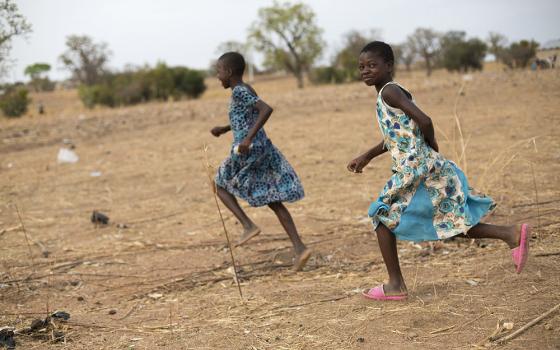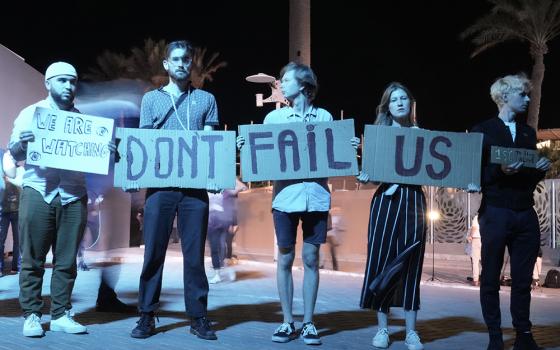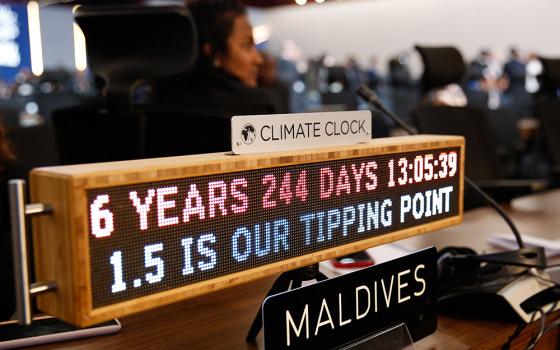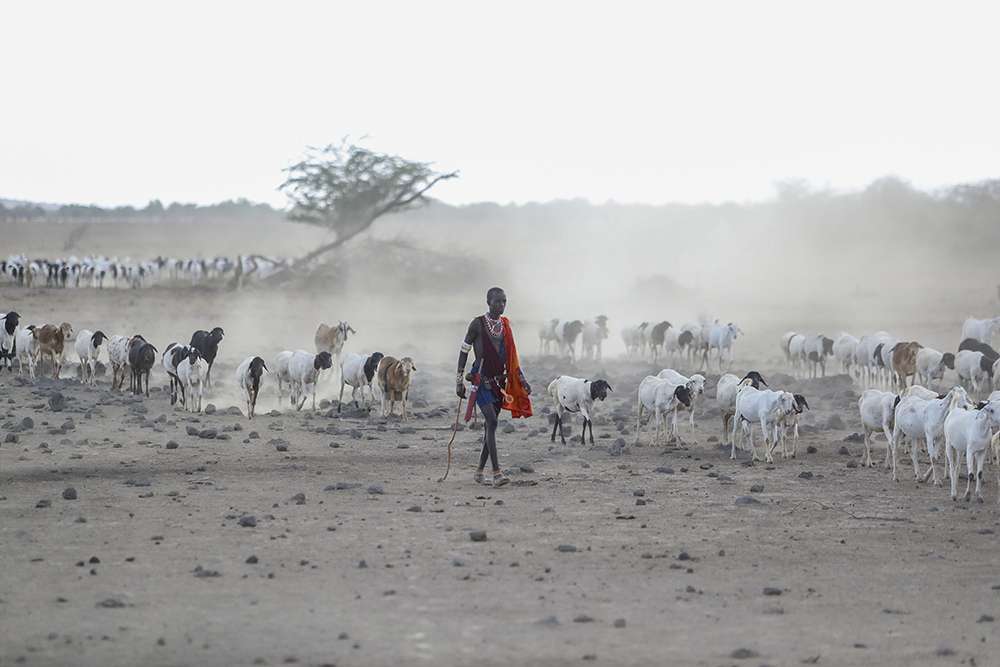
A Masai man walks with his livestock in search of grassland for them to graze on Nov. 9 at Ilangeruani village, near Lake Magadi, in Kajiado County, Kenya. Parts of Kenya have experienced four consecutive seasons with inadequate rain in the past two years, with dire effects for people and animals, including livestock. (AP/Brian Inganga)
It is around 11 a.m. in the remote Kisoso village in southern Kenya's Kajiado County, about 100 kilometers south of the capital Nairobi. The scorching sun has just begun wreaking havoc as dry winds blow violently with no traces of rain in sight.
Noor Lenku, a livestock farmer, sits on the skull of one of his dead cows just outside his hut, talking to himself as he observes heaps of skeletons of other animals that succumbed to the deadly drought conditions a few months ago.
With one hand on his left cheek, Lenku, 58, looks lonely and depressed. He has survived three days without food. Eventually, he looks up in the sky and says, "These are the last times. No living thing will survive in this world, we will all perish just like our livestock. Nature has no human face."
Lenku is one among an estimated 4.2 million Kenyans whose lives have been devastated by a relentless and punishing drought that has lasted close to two years and has triggered food insecurity, livestock deaths and conflicts among communities.
The drought, the worst in four decades in the Horn of Africa, has been linked to climate change, as rising temperatures have joined record-low rainfall throughout the region. Other factors, like the COVID-19 pandemic, have exacerbated the hunger crisis and conflicts. In Kenya's eastern region, Somali herders driving hundreds of camels and goats have engaged in a fight with farmers in Kitui County for allowing their animals to feed on crops as they search for water and pasture.
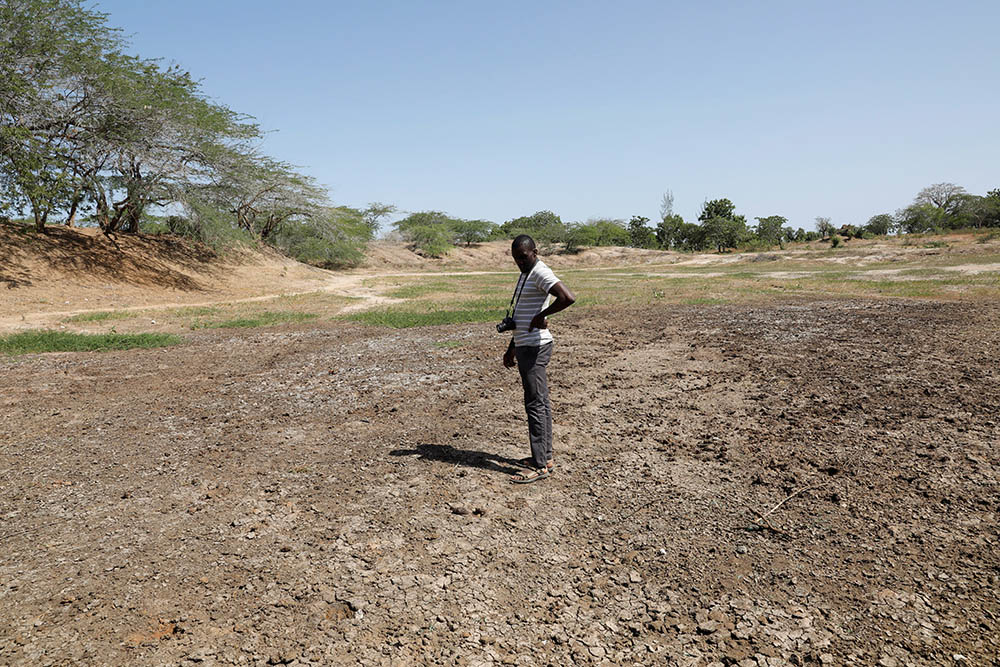
Scientist Chris Shitote examines a dry water hole in Kilifi, Kenya, Feb. 16. (CNS/Reuters/Baz Ratner)
It is these conditions — consequences of climate change — that face Kenya and other African nations as world leaders converge in Sharm el-Sheikh, Egypt, for COP27, the latest United Nations climate change conference.
Organizations including Catholic churches, humanitarian agencies, individuals and the Kenyan government have taken steps to supply food rations, fodder and clothes to thousands of drought-stricken families like Lenku's. A father of eight, he has been left at home with his wife and three youngest children while others have moved with their remaining livestock in search of food, water and pasture.
In May, the Kenya Conference of Catholic Bishops launched a drought appeal initiative to help families affected by hunger in 14 Catholic dioceses of East Africa. The initiative targeted to raise about $2.5 million. The church in September started disbursement of food rations in various parts of the country to people facing hunger, malnutrition and loss of livelihood.
"The Catholic Church has started distributing food rations to the victims of hunger," Nairobi Archbishop Philip Anyolo told EarthBeat. "And I want also to appeal to both individuals and organizations to respond as fast they can to [the] hunger crisis by providing relief food to the affected families."
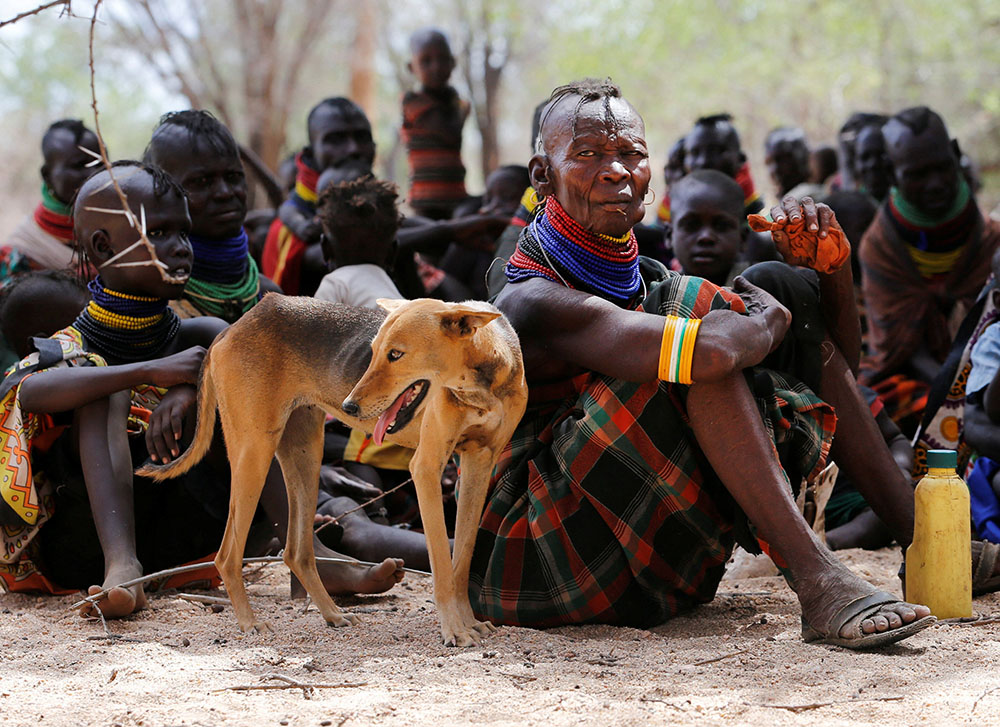
A woman from the Turkana pastoralist community affected by the worsening drought sits by her dog at a medical clinic in Kakimat, Kenya Sept. 27. The clinic is run by the United Nations Children's Fund and the Kenyan Red Cross. (CNS/Reuters/Thomas Mukoya)
Anyolo mentioned Marsabit, Kitui, Garissa, Wajir and Lodwar as the worst-hit areas where the church has started supplying food donations. Families in some of these areas have turned to wild fruits, grass and roots for survival. Anyolo urged fellow Kenyans to support each other however they can.
"Let us embrace the spirit of sharing whatever small we have in terms of food stuff to save our brothers and sisters who are starving in various parts of the country," the archbishop said.
Economically, livestock keepers have been among the most affected by the calamity, as thousands of their animals have already succumbed to the drought, marking huge losses for ranchers.
In Kajiado County, for example, a mature emaciated cow that normally sold for $500 or more when healthy is now being sold for $15, making the enterprise unprofitable for many.
Before the drought, Lenku had more than a hundred head of cattle, but most have now died. Others he has had to sell at below-market prices in order to get money to buy food for his family. As for the remaining herd, Lenku says they will soon die if rain does not begin to fall.
"I've sold [the] majority of my animals at throwaway prices and others have succumbed to the drought since the beginning of the year," Lenku said. "We've not experienced such drought in many years. It has cost us a lot."
Advertisement
"All my wealth is gone, I have nothing," he added. "My family has gone for a week without food and water. My children are now malnourished. We will all die if it continues like this."
Like Lenku, many livestock keepers in the country have come face to face with the vagaries brought by climate change.
Joseph Kapejo, director of the National Environmental Management Authority in Kajiado County, said one of the few ways residents can avoid huge livestock losses as the drought persists is to minimize the number of animals they are keeping. Large cattle herds can lead to other environmental problems, he said, such as overgrazing that leaves soil vulnerable to erosion and contributing to climate change through the release of methane gases.
A huge parcel of land that Lenku's community depends upon to feed their livestock is now brown and dusty, a far cry from the pure green pasture with water-filled pans that it once was. The dry winds that start from the ground blow almost constantly, with their dusty gales carrying clothes, plastic, papers and other light materials into the sky. Herders must tighten up their shuka (traditional clothing of the Masai people) or risk being exposed. Thickets have gone dry, too, making the area vulnerable to wildfires.
"It is bad," Lenku summarizes.
"I have never experienced a drought like this. The ground is too hot, not even an insect can survive in the soil," he said, adding that walking around with bare feet "feels like stepping on a hot metal."
'My family has gone for a week without food and water. My children are now malnourished. We will all die if it continues like this.'
—Livestock farmer Noor Lenku
According to Kenya Red Cross Society, 23 of Kenya's 47 counties are facing hunger, with 13 at severe risk and in dire need of relief and food.
The search for food, water and pasture has led thousands of students to leave schools, another blow to an education system still trying to recover from the COVID-19 pandemic. In the counties of Samburu and Marsabit, more than 13,000 pupils are struggling to stay in school, while 2,000 others have already dropped out, as have 1,000 in Kajiado.
Peter Bita, Kajiado County director of education, said that the drought has interrupted learning for thousands of Kenyan pupils as the government continues to work to normalize the academic calendar that has been disrupted by the pandemic.
In July, the Kenyan Red Cross reported that about 800,000 children, most of them below the age of 5, suffer malnutrition. The organization warned that figure might rise as the situation continues deteriorating.
And according to a Sept. 28 report on food insecurity, 884,000 children aged 6-59 months face acute malnourishment, and nearly 116,000 pregnant or lactating women are acutely malnourished. Both figures are slight declines since a June report.
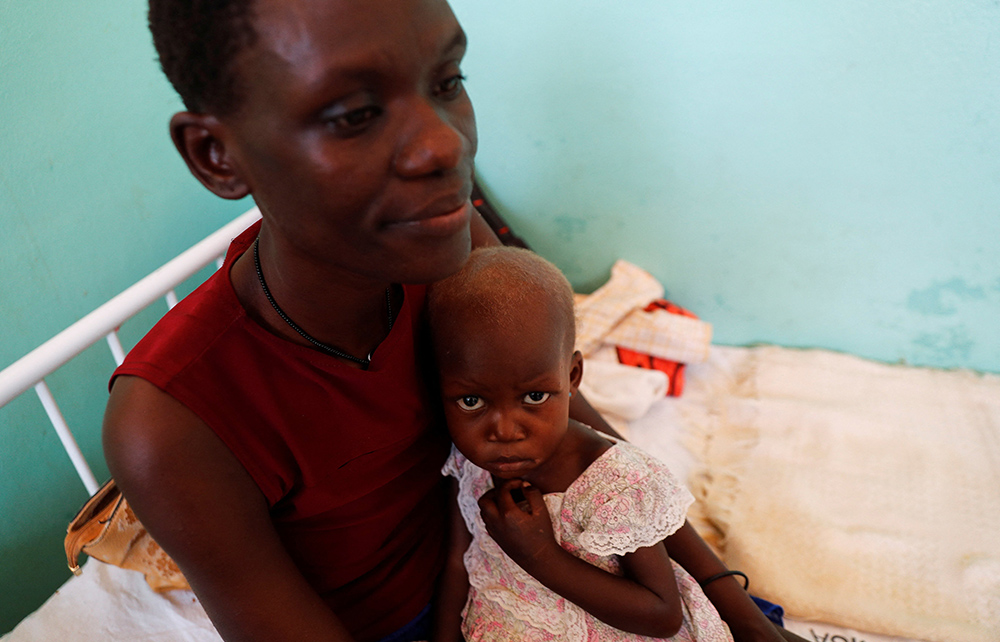
A woman holds her severely malnourished son at a hospital in Lodwar, Kenya, Sept. 26. (CNS/Reuters/Thomas Mukoya)
Upward of 4.35 million people face food insecurity and need humanitarian assistance, according to an October report from Kenya's National Drought Management Authority, an increase of nearly 1 million since February. It added that the drought situation continues to worsen in 20 of the 23 arid and semi-arid counties.
Across the Horn of Africa, upward of 22 million people face food shortages.
In June, the drought monitoring agency expressed "grave concerns" with elevated risks of a fifth below-average rainy season in the final three months of the year after four consecutive failed rainy seasons.
Already, the drought and hunger crisis has forced nearly 1 million people in Kenya and Somalia to leave their homes in search of sustenance, according to the International Red Cross.
Hussein Alio, Kajiado County director for the National Drought Management Authority, lamented that most of the families in Kajiado have fallen back into extreme poverty, leaving some to beg for help on the streets.
In Lenku's view, countries that have produced the most greenhouse gases should compensate for the severe losses faced in Kenya. He said that COP27 should invite people like them who live in regions most impacted by climate change to come and give testimonies, instead of hosting the rich who have never come face to face with ravages of an acceleratingly warming world.
"People like us, we're the ones [who are] supposed to attend such a summit. ... We have lost our livelihoods and we're now poor," he said.




